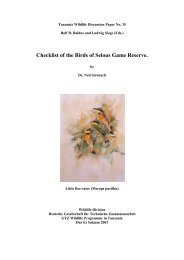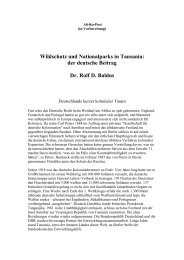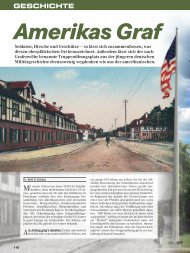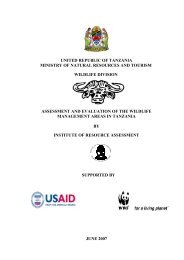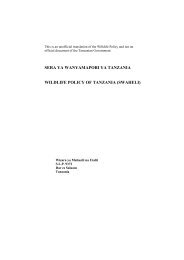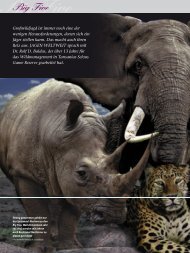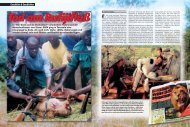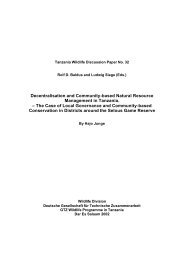Mulilo. About 78,000 people of more than six ethnic groups live in East and West Caprivi, the majority ofwhom practise subsistence agriculture, with some cash cropping, and depend on trees, wild fruits, fish, waterlilies, reeds and grasses for food, grazing, shelter, fuel and farming implements. Only 15% of the populationlive in the main town of Katima Mulilo. Four main languages are spoken, with Lozi the most dominant; 4%speak Bushman (San) languages, principally Khwe. The 4,000 Khwe people live in ten villages of WestCaprivi within Bwabwata National Park between Divundu and Kongola. The Khwe form the large majority ofthe population. Other population groups are the !Kung and Hambukushu. Not long ago, Ben Ngobara waselected as the new Khwe Chief in a democratic election recognized by the Namibian Government, assuccessor to the late Kippi George. Subsequently, the members of the <strong>com</strong>munity established theKyaramacan Residents’ Trust with ten <strong>com</strong>munity representatives serving on the board.Parks, People and WildlifeAntiquated protected area management is linked to colonialism and imposed foreign cultural norms.Strategies have relied heavily on measures to keep out people. Local people were considered a threat to<strong>wildlife</strong>. The establishment of protected areas all over Africa severely affected the livelihoods and integrity ofresident peoples and still continues to do so. These negative effects severely eroded local support forprotected areas. With a unique innovative approach the Namibian Ministry of Environment & Tourismchanged the status of the Bwabwata National Park. This allows the <strong>com</strong>munities living there to draw benefitsfrom <strong>wildlife</strong> and tourism in the park in line with the conceptual framework of the Namibian conservancyprogram. The result shows the “Parks and Neighbors” concept in action where protected areas stimulateregional and local development through a <strong>com</strong>bination of sustainable extractive and non-extractive useoptions. The enlightened policy of the Namibian Government thus created a positive <strong>com</strong>munity attitudetowards Bwabwata National Park.The program is a partnership between MET, the Namibian Association ofCBNRM Support Organizations (NACSO), IRDNC, NNF, WWF, and a variety of conservation anddevelopment NGOs as well as established and emerging conservancy <strong>com</strong>mittees. Funding has beenobtained from USAID, WWF and the Namibian Government. The program is active throughout theconservancy areas of Namibia. The <strong>com</strong>munities’ response to the acquisition of rights over <strong>wildlife</strong> has beenreflected by <strong>wildlife</strong> husbanding efforts that have reversed downward population trends and precipitatedunprecedented <strong>wildlife</strong> recoveries across northern <strong>com</strong>munal areas.The award of the Buffalo and Kwandoconcessions to hunting safari operators by the Kyaramacan Association is, however, THE ground-breakingevent the Khwe have been waiting for since 1990. Now they receive their first benefits from the Park’s<strong>wildlife</strong> resources.94
Bwabwata National ParkThe Bwabwata National Park was formerly known as Caprivi Game Park after it was proclaimed in 1968.Until Namibia’s independence in 1990, the 5,715 Km 2 Park was controlled and patrolled by the SADF. It hassince been managed by the Ministry of Environment and Tourism (MET) as a conservation area. In 1999, theNamibian Government renamed this park Bwabwata National Park and is in the process of adjusting theborders to include the Mahango Game Park and Kwando Triangle. Bwabwata National Park is 32 km wide(the entire width of the Caprivi strip) and 190 km long and its unspoiled wilderness stretch from theOkavango river in the west to the Kwando river in the east, bordering with Angola in the north and Botswanain the south. Traffic in this area is restricted to the main road between Kavango and Eastern Caprivi.Mudumu National Park lies east of the Kwando where it borders on Botswana, and further south and westis Mamili National Park. The terrain is generally flat with sporadic 30 to 60 meters high vegetation-covereddunes. The deciduous woodlands are dominated by trees such as wild seringa, copalwood, Zambezi teak,wild teak, wild raisin species, and bushwillow. Roan and kudu roam throughout the area, while buffalo occurtowards the west in the Buffalo Core Conservation Area and in the east along the Kwando River. Huge herdsof elephant can be observed during the dry season (June-November). Because there is no surface water,most species congregate along the Okavango and Kwando rivers and at the Malombe and Ndwasa pans inthe north east. As many as 339 bird species have been recorded in West Caprivi.The area is covered in thick deposits of Kalahari sands with very little of the underlying geology exposed,except along river courses. The extensive Kalahari sands and the rivers with their associated flood plains arethe two major features which shape the landscape: river floodplains, serrated by old river channels anddominated by reed and papyrus beds as well as grasslands; along the watercourses, riverine woodlandssupport a diversity of tall trees; old river drainage lines under windblown sand deposits support Mopanewoodlands and in the extensive sand dunes are covered by Kalahari woodlands.Tender ProcessIRDNC, NNF, WWF, and the MET assisted the Kyaramacan Association to establish and apply for quotasfor two hunting concessions in Bwabwata National Park. This assistance included preparation of tenderdocuments, advertising the concession through NAPHA, announcement and review of tenders, interviewinga select number of outfitters, drawing up contracts and hunting guidelines, and awarding the concessions totwo safari outfitters. The mentioned NGOs, along with the MET, will support the Kyaramacan Association inthe management of the trophy hunting concessions later this year.The tender process distinguished between trophy animals with a set quota and problem animals for whichno quota is provided. The category “trophy animals” is again subdivided in a “guaranteed” and an “optional”payment section.The successful bidder is obliged to pay in full for the <strong>com</strong>plete “guaranteed” part of the authorized quota(the quota for which payment is “guaranteed” in the Buffalo and the Kwando Concessions consists perconcession of 4 elephant bulls, 4 buffalo bulls, 1 sable (optional for the Kwando concession), 3 kudu, 1duiker, 1 steenbuck, 1 lion and 1 leopard. The full payment is due even if the quota is not <strong>com</strong>pletely utilized.Animals on “optional payment quota” have to be paid for only after the animal has been successfully huntedor wounded by the hunter. The prices for such animals are also based on the offer made by the outfitter inthe successful tender document. The Buffalo Concession has the following species as optional quota: 4elephant bull, 4 buffalo bulls, 1 buffalo cow, 1 leopard, 1 hyaena, 1 sable, 1 crocodile. In the KwandoConcession the quotas are identical, but two spotted hyaena are offered additionally.In both concessions problem animals, if so designated by the appropriate authorities, can also be huntedand the outfitters had to offer individual trophy fees for a range of species (elephant, lion, buffalo, hippo,hyaena, crocodile, and leopard) with a prescribed reserve price as a minimum bid. The KyaramacanAssociation and Ministry of Environment and Tourism (MET) must formally declare and designate anindividual animal as a “Problem Animal” prior to the hunt. The hunt will be undertaken under the guidance ofa MET and Kyaramacan Association official who will identify the problem animal. A full report must besubmitted to MET and the Association. Interestingly the contract also states “should the concessionaire befound to be influencing declaration of a problem animal, then such animal(s) shall be deducted from the95



